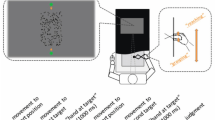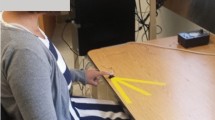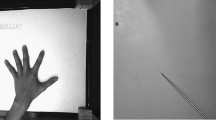Abstract
Previously, we observed changes in the scale, rotation, and location of drawn shapes when subjects simultaneously performed a secondary task, but not in the shape or proportion of the drawing. We suggested the secondary task impacted motor planning and execution or proprioception of the primary task. To isolate for proprioceptive effects, here we used the same secondary task during passive shape perception. A robotic manipulandum moved the subject’s hand around the perimeter of a template shape and then a test shape differing in size, proportion, or location. Subjects also performed the same primary task while simultaneously performing a secondary task of reporting the orientation of right or left tilted arrows. We compared the performance between single and dual task, and different workspaces. In single-task conditions, subjects perceived scale, location, and proportion very close to the actual (all biases under 1 cm). A secondary task only increased the uncertainty range for judgment of scale, with no other effect. Subjects judged shapes in the centered workspace to be smaller and closer relative to the template compared with those in the peripheral workspace, although in that workspace, it was more difficult to discern changes in the proportion of the shape. The result for scale in the current passive paradigm is not different from our active study in which efference copy was available. This suggests that the scale parameters of the shape, whether actively or passively encountered, are disrupted by task interference at the level of proprioception or sensory integration rather than motor planning and execution.







Similar content being viewed by others
References
Adamovich SV, Berkinblit MB, Fookson O, Poizner H (1998) Pointing in 3D space to remembered targets. I. Kinesthetic versus visual target presentation. J Neurophysiol 79:2833–2846
Averbeck BB, Chafee MV, Crowe DA, Georgopoulos AP (2002) Parallel processing of serial movements in prefrontal cortex. Proc Natl Acad Sci USA 99:13172–13177. doi:10.1073/pnas.162485599
Averbeck BB, Chafee MV, Crowe DA, Georgopoulos AP (2003) Neural activity in prefrontal cortex during copying geometrical shapes. I. single cells encode shape, sequence, and metric parameters. Exp Brain Res 150:127–141. doi:10.1007/s00221-003-1416-6
Bodegard A, Geyer S, Herath P, Grefkes C, Zilles K, Roland PE (2003) Somatosensory areas engaged during discrimination of steady pressure, spring strength, and kinesthesia. Hum Brain Mapp 20:103–115. doi:10.1002/hbm.10125
Bullock D (2004) From parallel sequence representations to calligraphic control: a conspiracy of neural circuits. Mot Control 8:371–391
Carey DP, Hargreaves EL, Goodale MA (1996) Reaching to ipsilateral or contralateral targets: within-hemisphere visuomotor processing cannot explain hemispatial differences in motor control. Exp Brain Res 112:496–504
Carson RG, Goodman D, Elliott D (1992) Asymmetries in the discrete and pseudocontinuous regulation of visually guided reaching. Brain Cogn 18:169–191
Cherry EC (1953) Some experiments on the recognition of speech, with one and with 2 ears. J Acoust Soc Am 25:975–979
Corbetta M, Miezin FM, Dobmeyer S, Shulman GL, Petersen SE (1991) Selective and divided attention during visual discriminations of shape, color, and speed: functional anatomy by positron emission tomography. J Neurosci 11:2383–2402
Craddock M, Martinovic J, Lawson R (2011) An advantage for active versus passive aperture-viewing in visual object recognition. Perception 40:1154–1163
Farrer C, Franck N, Paillard J, Jeannerod M (2003) The role of proprioception in action recognition. Conscious Cogn 12:609
Fiehler K, Burke M, Engel A, Bien S, Rosler F (2008) Kinesthetic working memory and action control within the dorsal stream. Cereb Cortex 18:243–253. doi:10.1093/cercor/bhm071
Henriques DY, Flanders M, Soechting JF (2004) Haptic synthesis of shapes and sequences. J Neurophysiol 91:1808–1821. doi:10.1152/jn.00998.2003
Ingram HA, van Donkelaar P, Cole J, Vercher JL, Gauthier GM, Miall RC (2000) The role of proprioception and attention in a visuomotor adaptation task. Exp Brain Res 132:114–126
Jones SA, Cressman EK, Henriques DY (2010) Proprioceptive localization of the left and right hands. Exp Brain Res 204:373–383. doi:10.1007/s00221-009-2079-8
Kesten H (1958) Accelerated stochastic approximation. Ann Math Stat 29:41–59
Kourtzi Z, Kanwisher N (2001) Representation of perceived object shape by the human lateral occipital complex. Science 293:1506–1509. doi:10.1126/science.1061133
Lashley KS (1951) The Problem of Serial Order in Behavior. In: Jeffress LA, California Institute of Technology, Pasadena. Hixon Fund (eds) Cerebral mechanisms in behavior; the Hixon symposium. Hafner, 1967, New York, pp 122–135
Laufer Y, Hocherman S, Dickstein R (2001) Accuracy of reproducing hand position when using active compared with passive movement. Physiother Res Int 6:65–75
Logothetis NK, Pauls J, Poggio T (1995) Shape representation in the inferior temporal cortex of monkeys. Curr Biol 5:552–563
Martin BC, Henriques DY (2010) The effects of secondary task interference on shape reproduction. Exp Brain Res 202:65–77. doi:10.1007/s00221-009-2112-y
Miquée A, Xerri C, Rainville C, Anton JL, Nazarian B, Roth M, Zennou-Azogui Y (2008) Neuronal substrates of haptic shape encoding and matching: a functional magnetic resonance imaging study. Neuroscience 152:29–39. doi:10.1016/j.neuroscience.2007.12.021
Oliver RT, Geiger EJ, Lewandowski BC, Thompson-Schill SL (2009) Remembrance of things touched: how sensorimotor experience affects the neural instantiation of object form. Neuropsychologia 47:239–247. doi:10.1016/j.neuropsychologia.2008.07.027
Otte E, van Mier HI (2006) Bimanual interference in children performing a dual motor task. Hum Mov Sci 25:678–693. doi:10.1016/j.humov.2006.07.008
Paillard J, Brouchon M (1968) Active and passive movements in the calibration of position sense. In: Freedman SJ (ed) The neuropsychology of spatially oriented behavior. Dorsey Press, Homewood, Ill, pp 37–55
Peltier S, Stilla R, Mariola E, LaConte S, Hu X, Sathian K (2007) Activity and effective connectivity of parietal and occipital cortical regions during haptic shape perception. Neuropsychologia 45:476–483. doi:10.1016/j.neuropsychologia.2006.03.003
Posner MI, Snyder CR, Davidson BJ (1980) Attention and the detection of signals. J Exp Psychol 109:160–174
Sawamura H, Georgieva S, Vogels R, Vanduffel W, Orban GA (2005) Using functional magnetic resonance imaging to assess adaptation and size invariance of shape processing by humans and monkeys. J Neurosci 25:4294–4306. doi:10.1523/JNEUROSCI.0377-05.2005
Schwartz EL, Desimone R, Albright TD, Gross CG (1983) Shape recognition and inferior temporal neurons. Proc Natl Acad Sci U S A 80:5776–5778
Scott SH (2004) Optimal feedback control and the neural basis of volitional motor control. Nat Rev Neurosci 5:532–546. doi:10.1038/nrn1427
Soto-Faraco S, Ronald A, Spence C (2004) Tactile selective attention and body posture: assessing the multisensory contributions of vision and proprioception. Percept Psychophys 66:1077
Todorov E (2004) Optimality principles in sensorimotor control. Nat Neurosci 7:907–915. doi:10.1038/nn1309
Author information
Authors and Affiliations
Corresponding author
Rights and permissions
About this article
Cite this article
Martin, B.C.W., Deeghan, K. & Henriques, D.Y.P. Bias and sensitivity of proprioception of a passively felt hand path with and without a secondary task. Exp Brain Res 228, 385–396 (2013). https://doi.org/10.1007/s00221-013-3572-7
Received:
Accepted:
Published:
Issue Date:
DOI: https://doi.org/10.1007/s00221-013-3572-7




